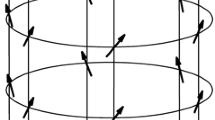Abstract
The development of chlorosomes was studied in the green phototrophic bacterium Chloroflexus aurantiacus during the adaptation from chemotrophic (aerobiosis in the dark) to phototrophic (anaerobiosis in the light) conditions. Electron micrographs confirmed that chlorosomes were essentially absent from chemotrophic cells. After 5 h of adaptation, however, about 70% of the cells exhibited the presence of chlorosomes and after 19 h essentially all the cells contained chlorosomes. During the first 5 h of adaptation, the number of chlorosomes per µm2 of membrane area increased from zero to 37 ± 7, and during the following 40 h to 55 ± 17. The latter phase was characterized by an increase in the chlorosome volume from 36 400 to 91 800 nm3. Chemotrophic cells contained all of the three polypeptides assumed to be localized in the chlorosome envelope. As estimated on the basis of bacteriochlorophyll (BChl) c of chlorosomes, the relative contents of all of the three polypeptides decreased during the adaptation to phototrophic conditions by a factor of about eight. It is proposed that largely empty chlorosome bags are already present in chemotrophic cells and that these as well as subsequently formed chlorosomes are filled up with BChl c. The results are discussed in light of the role of the 5.7 kDa polypeptide in the arrangement of BChl c aggregates within the chlorosome.
Similar content being viewed by others
References
Blankenship RE, Olson JM and Miller M (1995) Antenna complexes from green photosynthetic bacteria. In: Blankenship RE, Madigan MT and Bauer CE (eds) Anoxygenic Photosynthetic Bacteria, pp 399-435. Kluwer Academic Publishers, Dordrecht, the Netherlands.
Castenholz RW (1969) Thermophilic blue-green algae and the thermal environment. Bacteriol Rev 33: 476-504.
Feick RG, Fitzpatrick M and Fuller RC (1982) Isolation and characterization of cytoplasmic membranes and chlorosomes from the green bacterium Chloroflexus aurantiacus. J Bacteriol 150: 905-915.
Foiadl M, Golecki JR and Oelze J (1994) Bacteriochlorophyll c formation and chlorosome development in Chloroflexus aurantiacus. Photosynth Res 41: 145-159.
Foster JM, Redlinger TE, Blankenship RE and Fuller RC (1986) Oxygen regulation of development of the photosynthetic membrane system in Chloroflexus aurantiacus. J Bacteriol 167: 655-659.
Golecki JR and Oelze J (1987) Quantitative relationship between bacteriochlorophyll content, cytoplasmic membrane structure and chlorosome size in Chloroflexus aurantiacus. ArchMicrobiol 148: 236-241.
Holo H, Broch-Due M and Ormerod JG (1985) Glycolipids and the structure of chlorosomes in green bacteria. Arch Microbiol 143: 94-99.
Madigan MT, Petersen SR and Brock TD (1974) Nutritional studies on Chloroflexus, a filamentous photosynthetic, gliding bacterium. Arch Microbiol 100: 97-103.
Niedermeier G, Shiozawa JA, Lottspeich F and Feick RG (1994) The primary structure of two chlorosome polypeptides from Chloroflexus aurantiacus. FEBS Lett 342: 61-65.
Oelze J (1992) Light and oxygen regulation of the synthesis of bacteriochlorophylls a and c in Chloroflexus aurantiacus. J Bacteriol 174: 5021-5026.
Oelze J and Golecki JR(1995) Membranes and chlorosomes of green bacteria: Structure, composition and development. In: Blankenship RE, Madigan MT and Bauer CE (eds) Anoxygenic Photosynthetic Bacteria, pp 259-278. Kluwer Academic Publishers, Dordrecht, the Netherlands.
Schmidt K(1980)Acomparative study on the composition of chlorosomes (Chlorobium vesicles) and cytoplasmic membranes from Chloroflexus aurantiacus strain Ok-70-fl and Chlorobium limicola f. thiosulfatophilum Strain 6230. Arch Microbiol 124: 21-31.
Shiozawa J (1995) A foundation of the genetic analysis of green sulfur, green filamentous and heliobacteria. In: Blankenship RE, Madigan MT and Bauer CE (eds) Anoxygenic Photosynthetic Bacteria, pp 1159-1173. Kluwer Academic Publishers, Dordrecht, the Netherlands.
Sprague SG and Fuller RC (1991) The green phototrophic bacteria and heliobacteria. In: Stolz JF (ed) Structures of Phototrophic Prokaryotes, pp 79-103. CRC Press, Boca Raton, FL.
Sprague SG, Staehelin LA, DiBartolomeis MJ and Fuller RC (1981) Isolation and development of chlorosomes in the green bacterium Chloroflexus aurantiacus. J Bacteriol 147: 1021-1031.
Theroux SJ, Redlinger TE, Fuller RC and Robinson SJ (1990) Gene encoding the 5.7 kilodalton chlorosome protein of Chloroflexus aurantiacus: Regulated message level and a predicted carboxyterminal protein extension. J Bacteriol 172: 4497-4504.
Wullink W, Knudsen J, Olson JM, Redlinger TE and van Bruggen EFJ (1991) Localization of polypeptides in isolated chlorosomes from green phototrophic bacteria by immuno-gold labeling electron microscopy. Biochim Biophys Acta 1060: 97-105.
Author information
Authors and Affiliations
Rights and permissions
About this article
Cite this article
Foidl, M., Golecki, J.R. & Oelze, J. Chlorosome development in Chloroflexus aurantiacus. Photosynthesis Research 55, 109–114 (1998). https://doi.org/10.1023/A:1005901318614
Issue Date:
DOI: https://doi.org/10.1023/A:1005901318614




